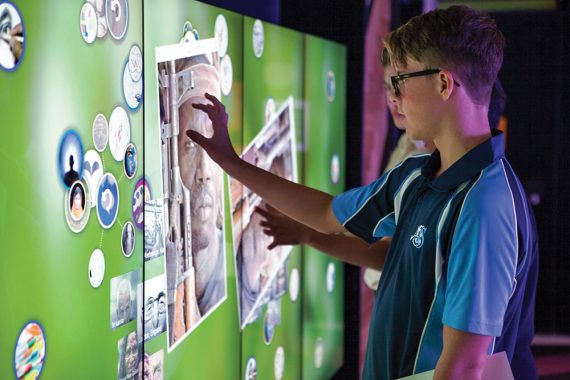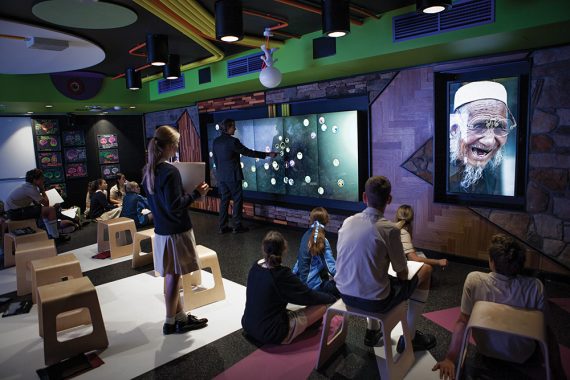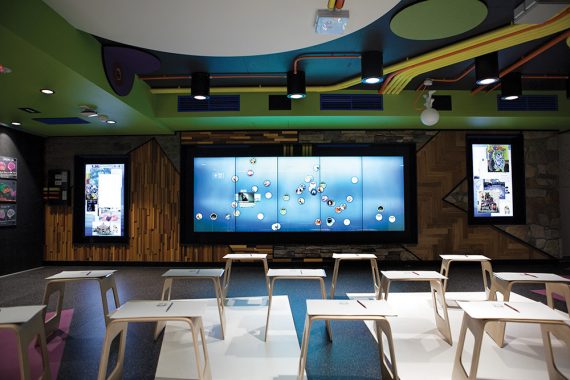
All Saints School’s Pioneering ‘Wonder Room’
Story: Preshan John
It’s hard to know if classroom videowalls and touchscreens would’ve impacted my high school report cards. Textbooks were the only way you learnt back then, and the deepest level of technological interaction was the odd Google search and typing up assignments in Word.
But those days are long gone. In a world that thrives on digital interaction and information consumption, the inevitable transfer of technology into the education sector continues to challenge our notion of what a ‘normal’ school education looks like.
All Saints Anglican School on the Gold Coast has embraced the ‘edutech’ revolution more than most. Six months ago the school inaugurated its ‘Wonder Room’ — a state-of-the-art learning hub that spent two years in intensive incubation.
While there’s plenty of AV geekery right around the room, the centre of attention is hard to miss: a large MultiTaction videowall configured as five seamless portrait displays.
MultiTaction has pushed the boundaries of what’s expected of your average touchscreen. Unlimited touch points means this solution is perfect for the classroom environment. Picture a group of knowledge-hungry students, each marking out their own screen real estate on the 5m x 2m videowall, voraciously devouring the vast amount of content before them without stepping on each others’ toes (or fingers).
WHAT A WONDER-FUL WORLD
This kind of install isn’t so different from a commercial signage execution. Regardless of the target market, the bottom line of any digital signage installation remains — eye-catching first impressions, easy interaction, and prolonged engagement. Only, in education, sales conversions aren’t a concern — the KPIs are somewhat different.
Jason Wainwright, Director of Learning Culture at All Saints, says the goal of the Wonder Room is in the name — to make the school community wonder about, and wonder at the world around them. Jason was the mastermind behind the mammoth quantity of information presented on the interactive videowall, and he worked extensively with digital specialists, Prendi, to bring the videowall to life.
Structuring and organising the diverse content was an important part of the process to ensure the interactive experience remained as open-ended as possible. Rather than force-feeding information to students, the idea was to launch them into their own journey of discovery. What’s more, the tactile component had to feel natural and enjoyable enough to keep students engaged long after the ‘wow factor’ had worn off. Prendi played a key part in keeping the fun and playfulness within the design.
“The Prendi guys were champions,” says Wainwright. “The whole time they were thinking about how this was going to work for little ones who can’t yet read, right through to those finishing Year 12. They were the ones building in little tricks to give kids a kick.”

CONTENT IS KING
For the sake of coursework relevancy, the videowall’s content generally adheres to the nationally-standardised Australian Curriculum. But the ‘whimsical thinking’ philosophy for the Wonder Room meant there was no reservation in loading extra-curricular information into the CMS as well. If it’s fascinating and promotes explorative thinking, it made the cut.
The way that information is presented is entirely unique. Instead of categorising content by subject (maths, science, English, etc.), Wainwright organised it according to Howard Gardner’s theory of multiple intelligences. Wait, what?
In 1983, Howard Gardner, a Harvard-educated brainiac, proposed that human beings have seven to 10 ‘intelligences’ by which we learn (as opposed to a single measure of intelligence). His theory challenges the assumption that linguistic and quantitative education forms a student’s optimal method for intake of information.
“Broadly, I’m tasked with looking at psychology, philosophy, neurology, and those sort of things,” says Wainwright. “So by using the 10 multiple intelligences — intrapersonal, interpersonal, mathematical-logical, verbal-linguistic, etc. — the main structure for the content was created. So any information we came across that could be useful goes straight into a category. There are 3500 content points entered into the system consisting of static images, MP4s, Word documents, PDF books, infographics. Within those 3500 graphics there might be over 10,000 data points.
“If a student would like to discover what fireworks are made of to create different colours, noises and effects, they need to consider which of the multiple intelligences is most likely to cover this. If they would like to look at a giant image of the Sistine Chapel’s ceiling, or at one of Banksy’s graffiti pieces, or at the world’s hardest mountain climbs, or nearest constellations, they must first engage their brain to consider where they might find it. The advantage here is that students will discover new ideas of interest along the way. This was really important to us and Prendi because we really want people to find links and realise connections.”
Commendably, this method means the videowall interface effortlessly caters to students of varying ages, personalities, and learning types. Because the selection icons are entirely pictorial, it’s a level starting point for anyone who fancies a go.
CHILD’S PLAY
In an education environment, efficient content management is as important as the content itself. Where commercial digital signage is often set-and-forget, the Wonder Room’s digital library has to be added to, subtracted from, and regularly updated. Wainwright, who doesn’t so much as own a mobile phone, is quick to point out his technical ineptitude. He credits Prendi for designing an intuitive back-end through which the immense database can be easily accessed and altered.
“I can’t write code, and I don’t understand code, but we needed the capacity to manipulate content on a daily basis. The Prendi team created a back-end so I could load this stuff in myself and visually move things into place. It was a complete team approach to how we do it.”

CROSS POLLINATION
As much as digital signage principles translate from commercial applications to educational, the reverse is also true — especially so in the case of All Saints’ Wonder Room where two years’ worth of thought and planning has gone into developing a structure that fosters creative interest and autonomous discovery.
The Wonder Room is also a testament to Prendi’s versatility and outside-the-box approach. Impressively, the company managed to realise Jason’s ambitious vision, construct a comprehensive, tailor-made digital solution from the ground up, and bring it to the big screen. “It’s been really great working with everyone at All Saints,” says Nat Russell, Creative Director, Prendi. “I think we’ve come up with something really unique and this is only the beginning.”
Wainwright: “It’s actually quite ridiculous how versatile the pieces Prendi has given us are. This is a space where, every direction you look, something is changing or interacting with you. Anyone who walks in there and uses the MultiTaction videowall is amazed. You immediately see what it does and the impact it has on kids. People don’t get bored with it.”
All Saints Anglican School: www.asas.qld.edu.au
Prendi: www.prendi.com.au

